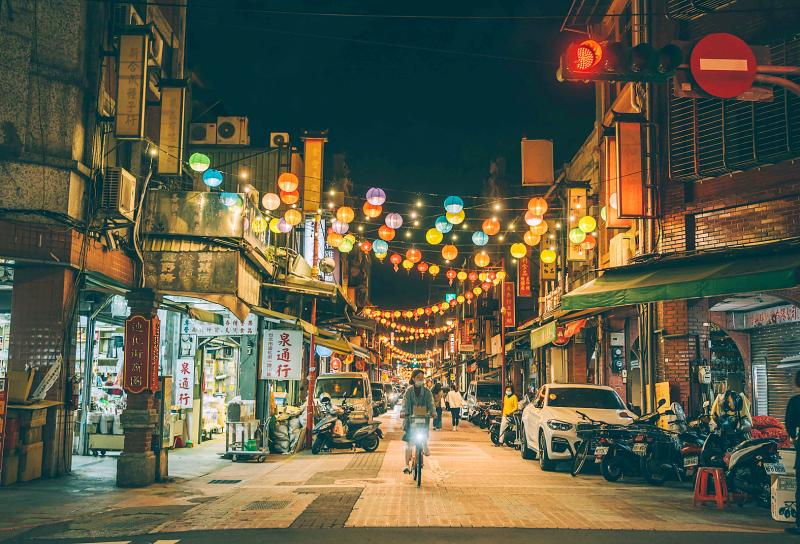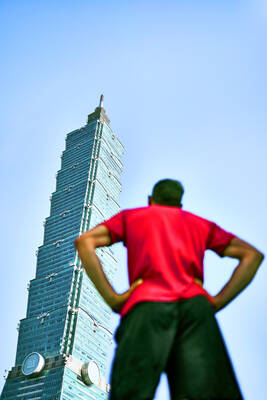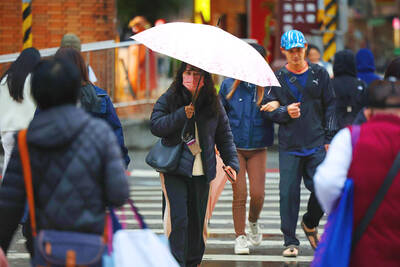The streams of shoppers, merchandise and signboards on the streets of Dadaocheng (大稻埕), one of the first international commercial districts in Taipei, easily elicit the hustle and bustle of what the area must have been like in the early 20th century.
Kuo Hsueh-hu (郭雪湖) captures such a scene in his 1930 work titled Festival on South Street (南街殷賑), which is one of the most celebrated pieces from Taiwan and the piece de resistance of the ongoing exhibition “Worldward: The Transformative Force of Arts in Taiwan’s New Cultural Movement” at the Taipei Fine Arts Museum (TFAM).
“Kuo vividly reproduced Dadaocheng’s prosperity and diversity,” said Sharleen Yu (余思穎), head of TFAM’s Exhibition Department and curator of the exhibition.

Photo courtesy of the Dihua Commercial District Development and Promotion Association
Dadaocheng was known as a place where progressive intellectuals gathered.
A painting of the area “is not only a reflection, but also an anticipation of Taiwan’s progress at the time,” she said.
Although Japan took control of Taiwan from Qing Dynasty China through the 1895 Treaty of Shimonoseki, social and cultural progress became bywords for Taiwanese intellectuals during Japanese rule.
In 1921, the Taiwan Cultural Association (TCA) was founded in Taipei by a group of Taiwanese intellectuals, who advocated for the participation of Taiwanese in the political process, from which they were largely excluded, and introduced the New Cultural Movement.
The movement gave rise to the first generation of Taiwanese artists to create art with strong Taiwanese characteristics and won art competitions.
“They proved their superior ability over their ruling-class counterparts, a way to fight for recognition and equality,” Yu said.
The TFAM exhibition, with more than 100 works by 37 artists from the 1920s to the 1940s, is dedicated to commemorating the centenary of the movement, which ushered in a golden age of Taiwanese art, the impact of which has reverberated throughout the century.
The exhibition is divided into five themes: Japanese painters and educators in Taiwan, art competitions and Taiwanese artists, modernity and local color, images of the modern woman and the rise of photography.
Kuo’s exuberant Festival on South Street, which is 1.88m long and hung in the center of the gallery, brought to life a busy and crowded scene in front of the Xia Hai City God Temple (霞海城隍廟) in Taipei during the Chung Yuan Festival (中元節).
The painting, which won an award at the second Taiwan Fine Arts Exhibition (Taiten) in 1928 and catapulted Kuo to fame, accurately depicted the diversity of Taiwanese culture, as exemplified in its colorful signboards written in Chinese and Japanese characters, and painted with Aboriginal patterns, as well as goods from Taiwan, China and Japan, which can be seen in the lower part.
What makes the painting so spellbinding is that it includes people from different walks of life, ensuring that everyone can easily identify with the work, Yu said.
It is also the first time in six years that the painting has been shown in public.
“The painting of gouache on a silk scroll is fragile and has to be kept at a certain temperature and humidity, which prevents it from being exhibited too often,” Yu said.
In the “Modernity and Local Color” section, one featured work is Chen Chih-chi’s (陳植棋) Chen-Jen Temple (真人廟), which won a special award at the fourth Taiten.
It portrays an ordinary and slightly dilapidated temple of the same name, overshadowing a white Western-style building next to it.
The painter specified the temple’s name for a reason: The painting was completed in 1930, the year that the Taiwanese People’s Party — nominally Taiwan’s first political party — relocated its headquarters next to the temple, which therefore became a symbol of Taiwanese, the museum said.
The party was banned in 1931.
Chen, who died at the age of 25, expressed his concerns and passion for politics by implicitly incorporating objects that contained hidden messages, as was commonly seen at a time of political oppression, Yu said.
The last section of the exhibition is dedicated to the image of modern women, in which Chen Chin’s (陳進) portrayal of women greets viewers with exquisite lines and warm colors, presenting a new image of women’s liberation.
Women’s liberation was one of the goals of the New Cultural movement.
“With more education for women and the abolition of foot binding, women’s body shapes and fashion changed from having more exercise and activities,” Yu said.
Following the changing times, Chen Chin, the first Taiwanese female artist to study in Japan, focused on elegant upper-class women in newly designed garments engaging in high-brow or outdoor recreational activities.
Her 1934 work, titled Out in the Fields (野邊), depicts a woman in a Taiwanese-style shirt and Japanese geta standing in a field with her children.
The woman’s complexion is serene and sophisticated, surrounded with blossoming flowers and emerald-colored bushes, all of which are painted with exquisite lines and soft colors, exuding a refreshing quality.
As the first Taiwanese female painter to be nominated at the Japanese Imperial Art Exhibition, the most prestigious art event in that country at the time, Chen once said: “I’m Taiwanese. I want to paint good works in a Taiwanese style. The important thing is to be better than the Japanese.”
It is unlikely that people in this period ever believed that a movement that called for political participation and equality, would eventually catalyze and accelerate the modernization of Taiwanese art.
These artists not only proved their worth as world-class artists, but also launched a belle epoque that still affects the art scene.
“These artists had a strong sense of mission,” Yu said. “Their works remind us how much they paved the way to search for and establish Taiwanese identity.”
“We are not only stunned by their skill, but also provoked to think about what they tried to leave us with 100 years ago, and carry it on into the future,” Yu said.
The exhibition runs until Nov. 28.

US climber Alex Honnold is to attempt to scale Taipei 101 without a rope and harness in a live Netflix special on Jan. 24, the streaming platform announced on Wednesday. Accounting for the time difference, the two-hour broadcast of Honnold’s climb, called Skyscraper Live, is to air on Jan. 23 in the US, Netflix said in a statement. Honnold, 40, was the first person ever to free solo climb the 900m El Capitan rock formation in Yosemite National Park — a feat that was recorded and later made into the 2018 documentary film Free Solo. Netflix previewed Skyscraper Live in October, after videos

Starting on Jan. 1, YouBike riders must have insurance to use the service, and a six-month trial of NT$5 coupons under certain conditions would be implemented to balance bike shortages, a joint statement from transportation departments across Taipei, New Taipei City and Taoyuan announced yesterday. The rental bike system operator said that coupons would be offered to riders to rent bikes from full stations, for riders who take out an electric-assisted bike from a full station, and for riders who return a bike to an empty station. All riders with YouBike accounts are automatically eligible for the program, and each membership account

NUMBERS IMBALANCE: More than 4 million Taiwanese have visited China this year, while only about half a million Chinese have visited here Beijing has yet to respond to Taiwan’s requests for negotiation over matters related to the recovery of cross-strait tourism, the Tourism Administration said yesterday. Taiwan’s tourism authority issued the statement after Chinese-language daily the China Times reported yesterday that the government’s policy of banning group tours to China does not stop Taiwanese from visiting the country. As of October, more than 4.2 million had traveled to China this year, exceeding last year. Beijing estimated the number of Taiwanese tourists in China could reach 4.5 million this year. By contrast, only 500,000 Chinese tourists are expected in Taiwan, the report said. The report

Temperatures are forecast to drop steadily as a continental cold air mass moves across Taiwan, with some areas also likely to see heavy rainfall, the Central Weather Administration (CWA) said. From today through early tomorrow, a cold air mass would keep temperatures low across central and northern Taiwan, and the eastern half of Taiwan proper, with isolated brief showers forecast along Keelung’s north coast, Taipei and New Taipei City’s mountainous areas and eastern Taiwan, it said. Lows of 11°C to 15°C are forecast in central and northern Taiwan, Yilan County, and the outlying Kinmen and Lienchiang (Matsu) counties, and 14°C to 17°C